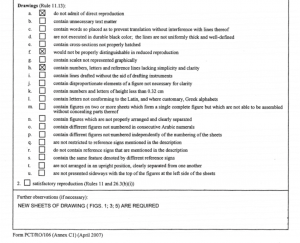This article discusses drawings that are used in patent applications and the importance of providing an unambiguous disclosure for the prior art. Our observations here are based on over 30 years of patent illustration performed at Gallagher’s Patent Drafting in the Boston area where we have created tens of thousands of patent drawings and enjoyed numerous discussions with professionals in the intellectual property field. The comments here should not be taken as legal advice.
In the course of our normal business operation, we receive many requests to correct patent drawings previously filed at a patent office by our clients. Typically, our clients will receive an office notice, such as the one below from the PCT (click for a larger image).
As you can see in the notice, Figs. 1, 3 and 5 are objected to. We then inform our client before starting work that we would only be formalizing Figs. 1, 3, and 5. In order to reduce costs, most clients’ preference is to prepare only the figures that are objected to. However, during this process, we may note that Figs. 2 and 4 contain the same or similar issues as the objected figures.
Why did the patent office not object to these figures as well? We have never received a satisfactory answer to this frequently occurring question. Most often, we only prepare the figures objected to unless instructed differently but is this the best course of action? Or, should we recommend to formalize all the drawings regardless of whether they were objected to or not? Since we are in the business of preparing patent drawings, we think you will know what
our answer is but please consider the following arguments as to why formalizing all drawings should be the preferred practice.
- To Discourage Infringement
Once the patent issues, it will be part of the prior art and an unambiguous disclosure clearly establishes the boundary of your patent to discourage a potential infringer. If the disclosure of the invention is unclear to the infringer or subject to interpretation, they might be encouraged to proceed. If an infringer knows with certainty that they are infringing, it acts as a discouragement.
- Ensuring the Protections Provided by the Patent
One of the basic tenets of the patent system is that in exchange for a full disclosure of an invention, a monopoly on the invention is given for a time period. Providing clear, readable drawings in a published application holds to this principle.
- Complete Clarity in Litigation
An argument could be made during litigation that unclear matter conveys information contrary to the patent’s claims or does not support the patent’s claims. Judges, juries, and opposing counsels may have different interpretations of ambiguous drawings affecting outcomes in trials and settlements.
- Reputation!
Patent attorneys should also consider the fact that their name is going on the application. Unreadable drawings that do not meet patent office standards in a published application does not support an image of providing a high quality work product.
- Client Satisfaction
We were told by a patent attorney that the first thing many clients want to see is the formal drawings prepared for their application. A complete set of drawings prepared using patent office standards creates a uniform appearance and a satisfied client.
A distinct, well executed set of patent drawings that clearly defines the line of battle for any potential litigation is part of the key to a successful patent. The increased value, client satisfaction, and patent protection can all be achieved through a complete set of formalized patent illustrations.


